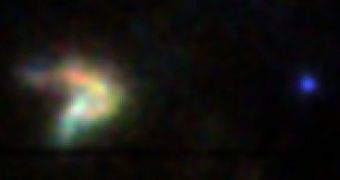When it was first discovered in the 1980s the deceptive shape of the object known as G350.1-0.3 indicated that it was most likely a background galaxy. Since nobody ever bothered to study it more closely, the object remained forgotten until recently when observations with ESA XMM-Newton X-ray Space Observatory revealed a shocking discovery. Not only that G350.1-0.3 is not a galaxy, but it is also one of the brightest and youngest supernova remnants in the Milky Way.
It was probably created about 1,000 years ago by a star that exploded at the end of its life. Supernova explosions are critical for the evolution of the universe, providing all the heavy elements required in the formation process of new stars and planets such as Earth. In the absence of supernova explosions elements heavier than iron would probably never be created since stars are not capable of producing any during their life.
The cloud of matter left behind in the aftermath of the explosion, called by astronomers supernova remnant, is generally extremely bright in the X-ray and radio spectrum and has a spherical or a ring-like shape, which is also the reason why G350.1-0.3 remained unstudied for such a long time.
By making use of the XMM-Newton telescope, Bryan Gaensler and Anant Tanna of the University of Sydney revealed that the shape of G350.1-0.3 has been distorted during the explosion by the presence of a dense cloud of gas, currently located about 15,000 light years away from Earth, which prevented the remnant to expand evenly in the surrounding space. "Only a handful of such young supernova remnants are known. So even having one more is important", says Tanna.
The size of the remnant, about 8 light years across, indicates that it must be about 1,000 years old and because it is so young and so bright it allows astronomers to study it more closely, in order to understand the violent way in which stars end their lives. "We're seeing these heavy elements fresh out of the oven. After 20 000 years, all sorts of explosions look more or less the same", says Gaensler.
As supernova remnants evolve in time, their features start to fade and the information related to the progenitor star and how the explosion occurred is lost in the expanding gas cloud. The shape of the remnant is usually related to the type of star and explosion that determined it, while the different chemical ratios can indicate whether or not the star had any objects orbiting around it, such as a stellar companion for example. "It may turn out that many of the youngest supernova remnants have these strange shapes. The hunt to find more is now on", says Tanna.
Although the explosion took place only 1,000 years ago, it couldn't have been noticed from Earth. "The X-ray data tell us that there's a lot of dust lying between it and Earth. Even if you'd been looking straight at it when it exploded, it would've been invisible to the naked eye", says Gaensler.

 14 DAY TRIAL //
14 DAY TRIAL //